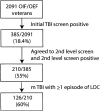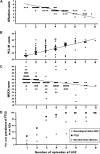A case-control study examining whether neurological deficits and PTSD in combat veterans are related to episodes of mild TBI
- PMID: 22431700
- PMCID: PMC3312078
- DOI: 10.1136/bmjopen-2011-000312
A case-control study examining whether neurological deficits and PTSD in combat veterans are related to episodes of mild TBI
Abstract
Background: Mild traumatic brain injury (mTBI) is a common injury among military personnel serving in Iraq or Afghanistan. The impact of repeated episodes of combat mTBI is unknown.
Objective: To evaluate relationships among mTBI, post-traumatic stress disorder (PTSD) and neurological deficits (NDs) in US veterans who served in Iraq or Afghanistan.
Methods: This was a case-control study. From 2091 veterans screened for traumatic brain injury, the authors studied 126 who sustained mTBI with one or more episodes of loss of consciousness (LOC) in combat. Comparison groups: 21 combat veterans who had definite or possible episodes of mTBI without LOC and 21 veterans who sustained mTBI with LOC as civilians.
Results: Among combat veterans with mTBI, 52% had NDs, 66% had PTSD and 50% had PTSD and an ND. Impaired olfaction was the most common ND, found in 65 veterans. The prevalence of an ND or PTSD correlated with the number of mTBI exposures with LOC. The prevalence of an ND or PTSD was >90% for more than five episodes of LOC. Severity of PTSD and impairment of olfaction increased with number of LOC episodes. The prevalence of an ND for the 34 combat veterans with one episode of LOC (4/34=11.8%) was similar to that of the 21 veterans of similar age and educational background who sustained civilian mTBI with one episode of LOC (2/21=9.5%, p-NS).
Conclusions: Impaired olfaction was the most frequently recognised ND. Repeated episodes of combat mTBI were associated with increased likelihood of PTSD and an ND. Combat setting may not increase the likelihood of an ND. Two possible connections between mTBI and PTSD are (1) that circumstances leading to combat mTBI likely involve severe psychological trauma and (2) that altered cerebral functioning following mTBI may increase the likelihood that a traumatic event results in PTSD.
Conflict of interest statement
Figures




References
-
- Hyder AA, Wunderlich CA, Puvanachandra P, et al. The impact of traumatic brain injuries: a global perspective. NeuroRehabilitation 2007;22:341–53 - PubMed
-
- Binder S, Corrigan JD, Langlois JA. The public health approach to traumatic brain injury: an overview of CDC's research and programs. J Head Trauma Rehabil 2005;20:189–95 - PubMed
-
- Warden DL. Military TBI during the Iraq and Afghanistan wars. J Head Trauma Rehabil 2006;21:398–402 - PubMed
-
- Hoge CW, McGurk D, Thomas JL, et al. Mild traumatic brain injury in U.S. soldiers returning from Iraq. N Engl J Med 2008;358:453–63 - PubMed
-
- Terrio H, Brenner LA, Ivins BJ, et al. Traumatic brain injury screening: preliminary findings in a US Army Brigade Combat Team. J Head Trauma Rehabil 2009;24:14–23 - PubMed
LinkOut - more resources
Full Text Sources
Miscellaneous
